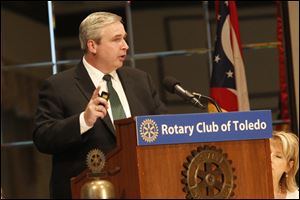
Fed speaker: Post-industrial success varies
Cities that boast education, regional approach get results
5/21/2013
Jeremiah Boyle, the Community Affairs Managing Director of the Federal Reserve Bank of Chicago, spoke with a packed audience of several hundred Rotarians.
Jeremiah Boyle wouldn’t be breaking any ground by telling rust-belt leaders that education is one of the answers for moving into a post-industrial economy.
“They would probably tell me before I told them, it’s really all about education, and it’s probably not education in only the traditional sense,” he said. “It’s about rethinking the pipeline of human capital getting to the right place at the right time to be able to sustain a growing economy.”
Mr. Boyle is the managing director of economic development in the Federal Reserve Bank of Chicago’s community development and policy studies division. He has spent the last 18 months digging into why some industrial cities have performed better than others as the U.S. economy changed and manufacturing jobs were lost.
The Federal Reserve Bank of Chicago covers a five-state area of Illinois, Indiana, Iowa, Michigan, and Wisconsin.
He and his colleagues looked within those states for cities that in 1960 had a population of at least 50,000, with at least 25 percent of workers employed in manufacturing jobs. They found 47 cities that met those criteria.
The research looked at things such as education, income, and population, comparing it both to other industrial cities and the national averages during the past 40 years. They chose 10 representative cities to dive into further, conducting dozens of interviews in an effort to better understand the numbers and what was happening behind them.
Mr. Boyle spoke Monday to members of the Toledo Rotary Club, outlining his findings. His research did not include Toledo, but he said there are some universal takeaways.
The cities that did better in the face of manufacturing job losses focused on education and human capital. They thought regionally. And while none turned their back on manufacturing, they looked for different manufacturing opportunities and diversified their economy.
In a sense, they used realistic optimism.
“A city like Green Bay [Wis.] will tell you, we’re never going to be the pharmaceutical capital of the world,” he said in an interview after his presentation. “If you’re going to be the pharmaceutical capital of the world, chances are we’re going to build the machines that build your machines. That’s what we do.”
Mr. Boyle also said Green Bay realized it already makes most of the thousands of components that go into wind turbines. That’s given them another way to market themselves.
“If you’re going to be a wind turbine manufacturer, come and take a look at what we’ve already got here,” he said.
The other cities researchers studied closely were Waterloo and Cedar Rapids, Iowa; Joliet and Aurora, Ill.; Fort Wayne and Gary, Ind.; Grand Rapids and Pontiac, Mich., and Racine, Wis.
And though the study looked at cities, successful areas didn’t fret over political subdivisions, instead taking a more regional approach. Typically, they had like-minded leaders willing to ignore election cycles to implement long-term plans.
On the education point, one of the challenges is that if you asked a dozen people how to improve education, you might get a dozen answers. It starts with primary education — the successful cities have done well in improving their rates of high school graduates, though many still lag behind national averages.
But it needs to go beyond that and beyond just encouraging people to earn four-year degrees. Focus needs to be put on retraining displaced workers as well as encouraging children to think about careers in high-tech modern manufacturing. Mr. Boyle said many employers in those cities struggle to find workers for high-skill jobs.
On the other hand, many of the fields that are projected to grow don’t offer jobs that pay a sustainable wage. That’s a problem without an answer to this point, he said.
So, the news isn’t all rosy. But Mr. Boyle said hope shouldn’t be lost, even for areas like Pontiac and Gary, which were among the worst the report looked at.
“Even in the cities that statistically underperform their peers, there are people in those cities who believe that there are strengths, that there are assets, and there’s a reason to be where they are,” he said. “As long as that’s true, just on a human level, you have to believe there’s hope.”
Contact Tyrel Linkhorn at: tlinkhorn@theblade.com or 419-724-6134.